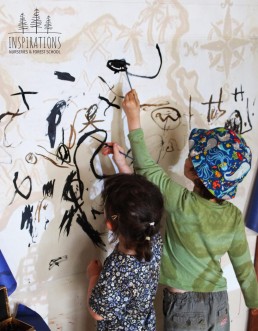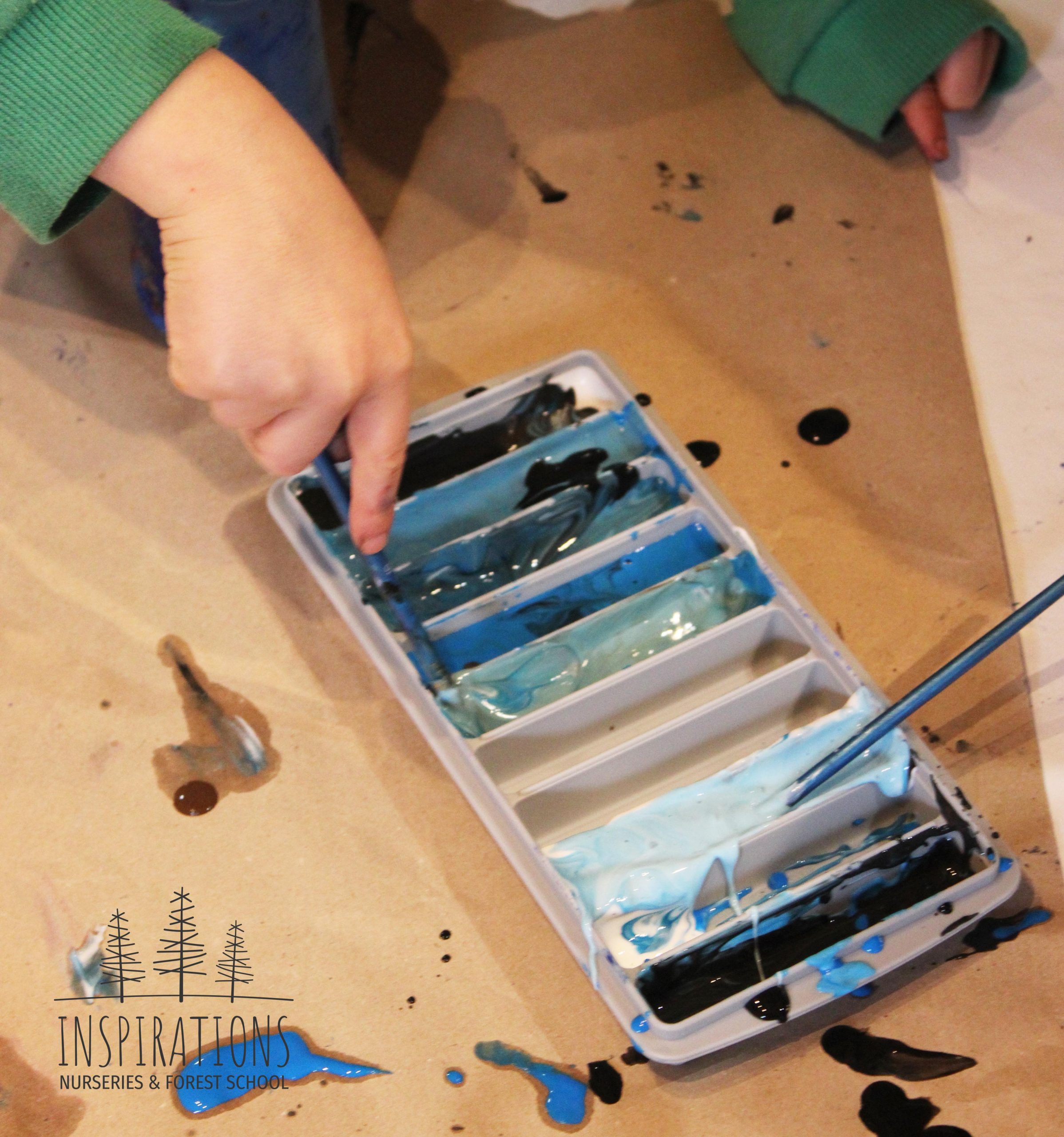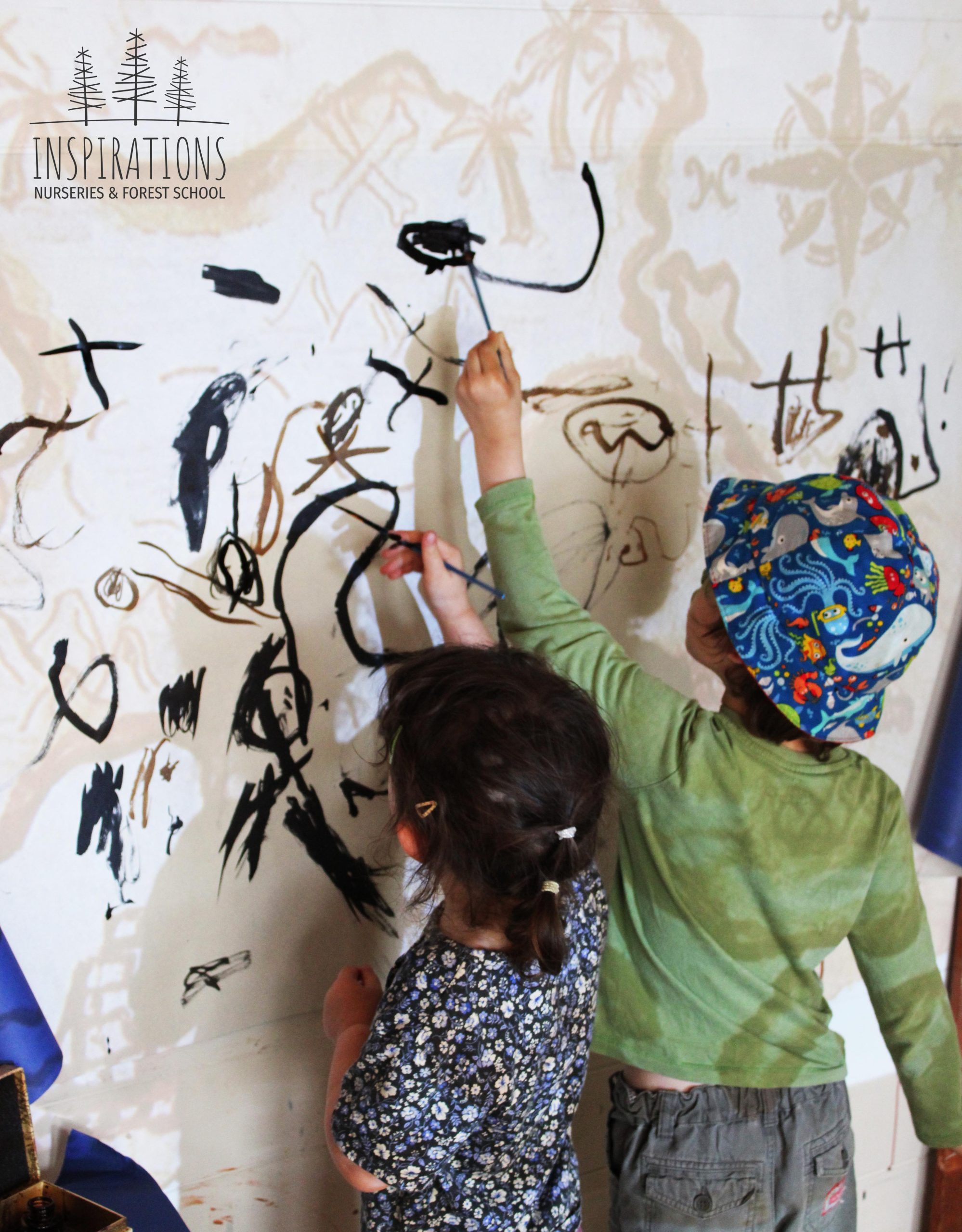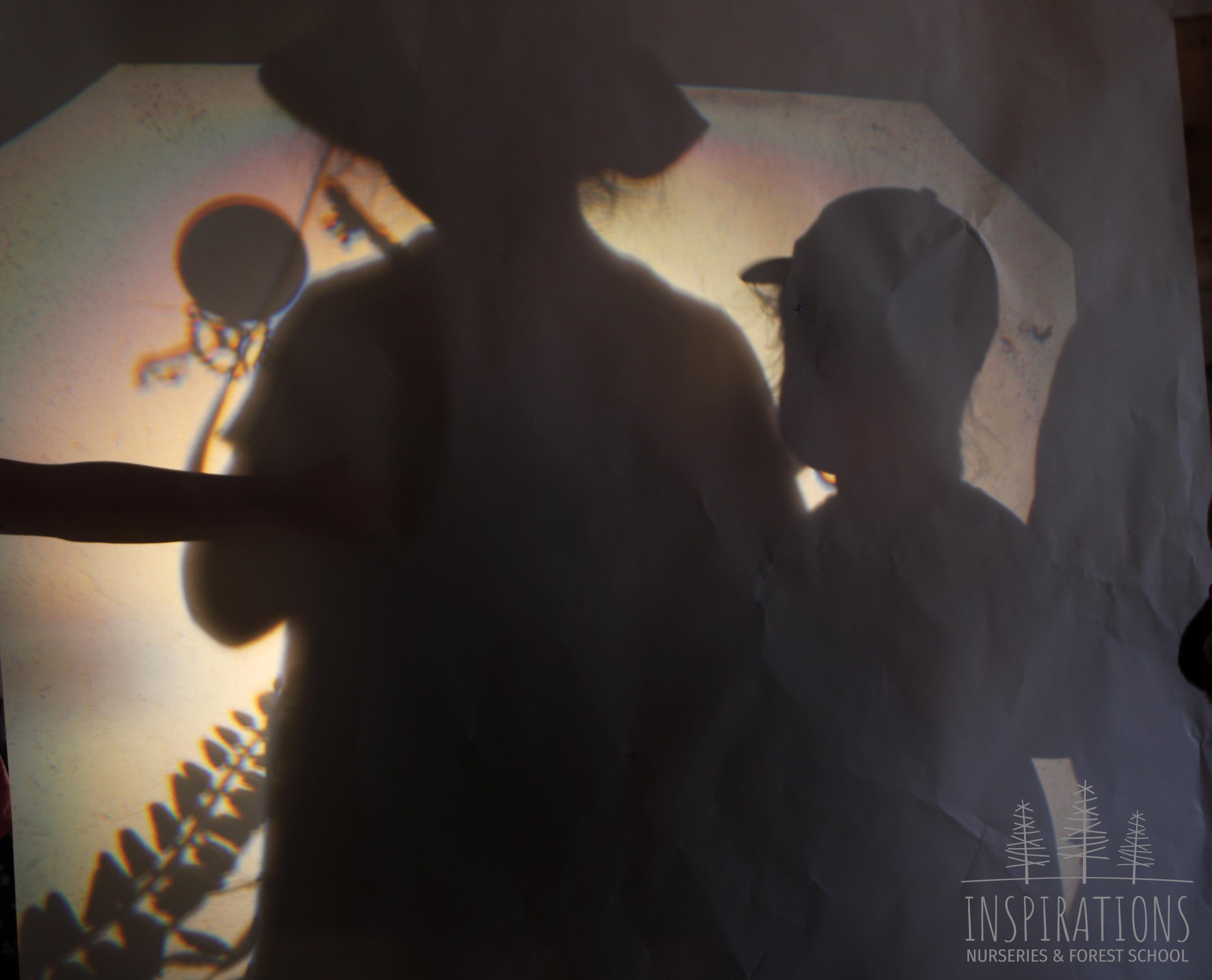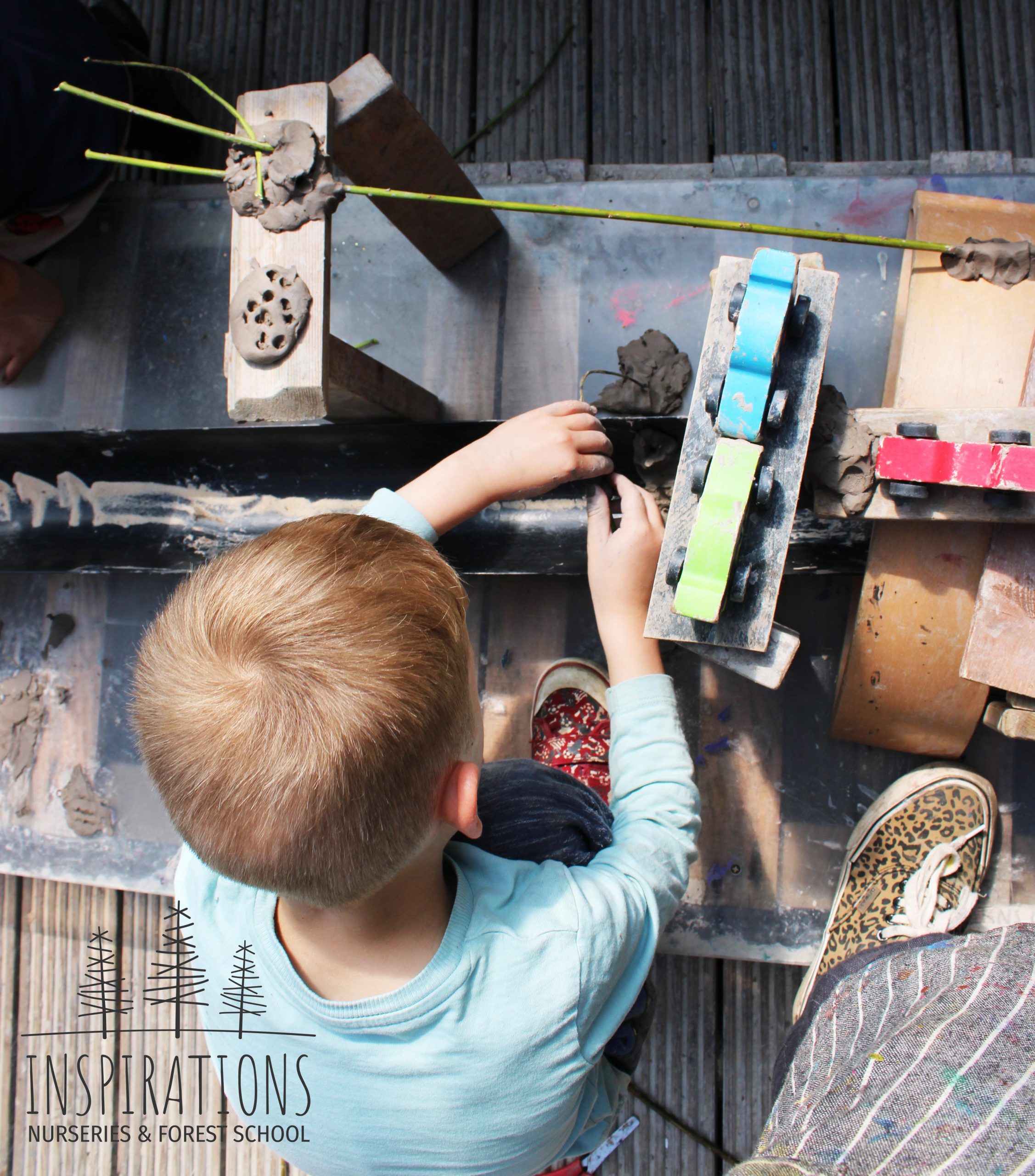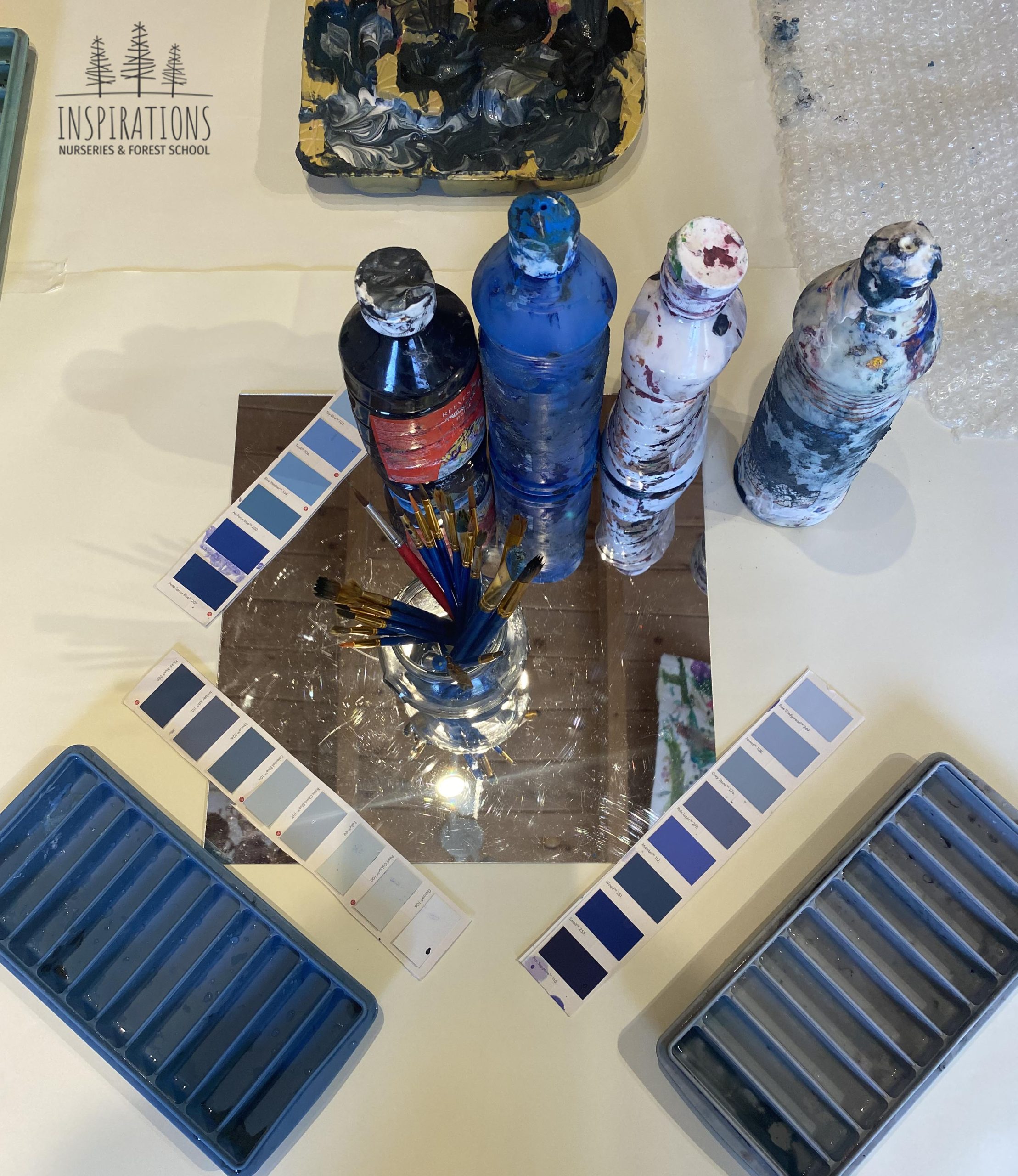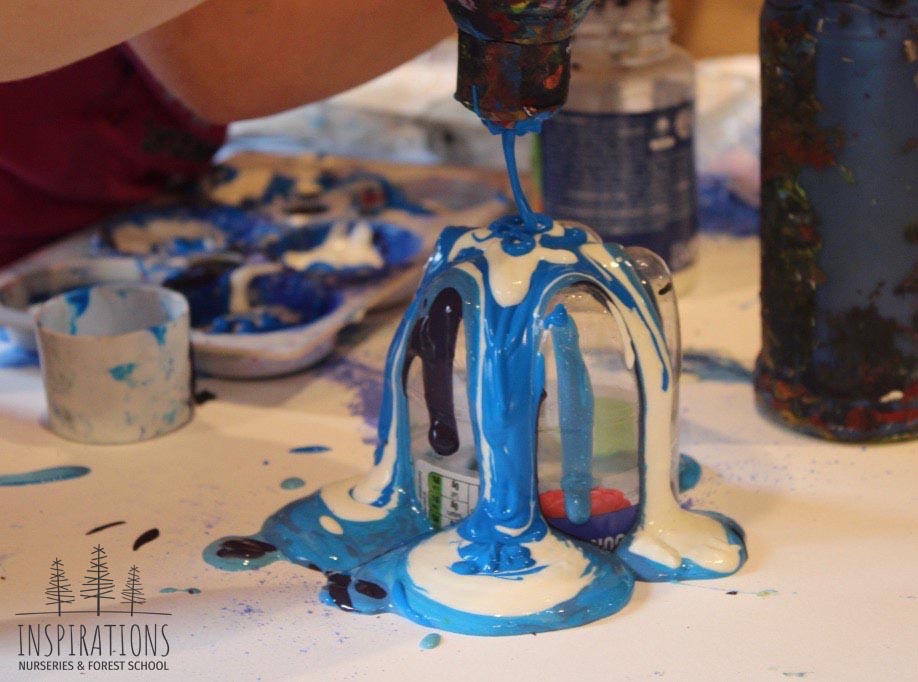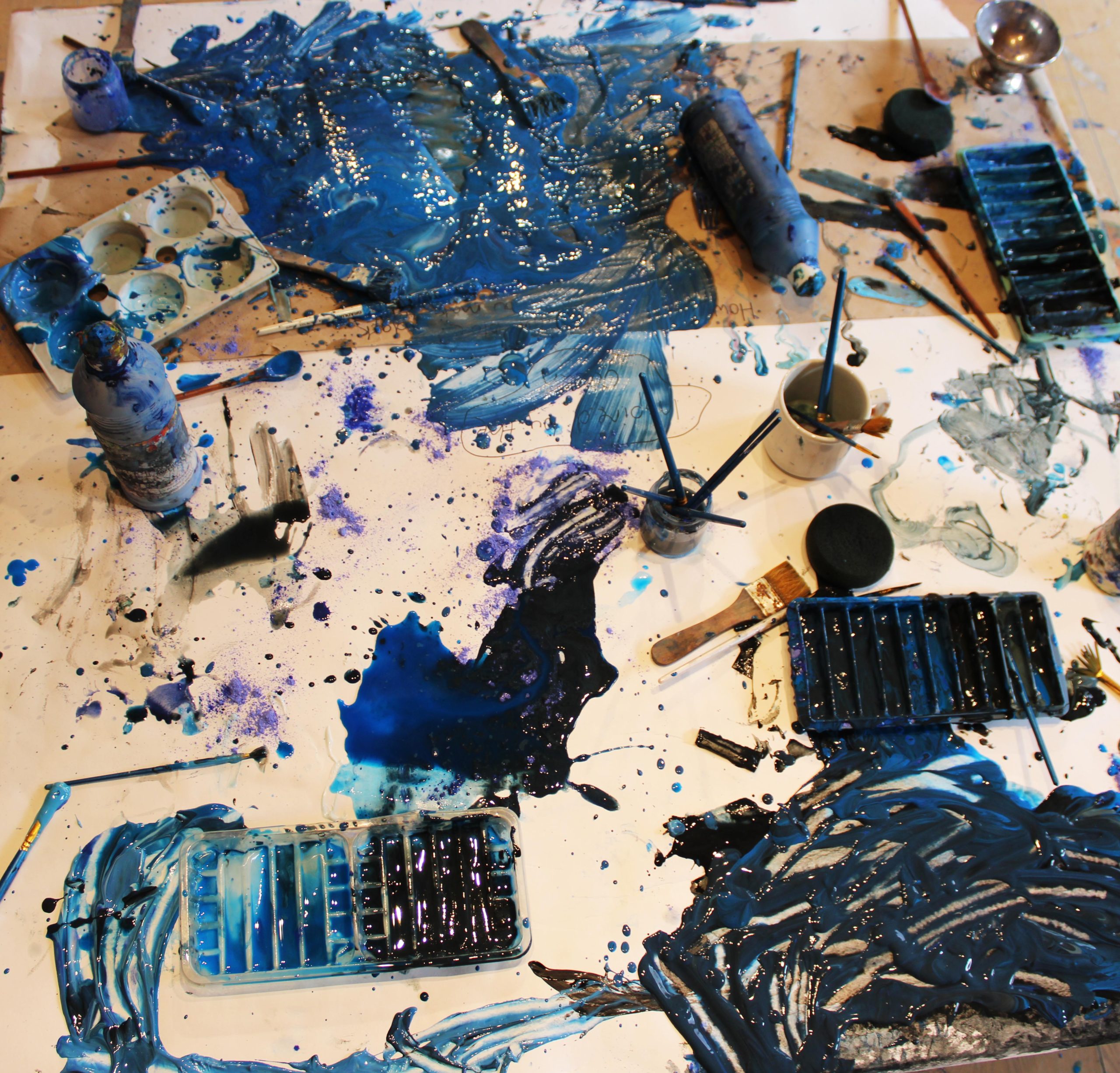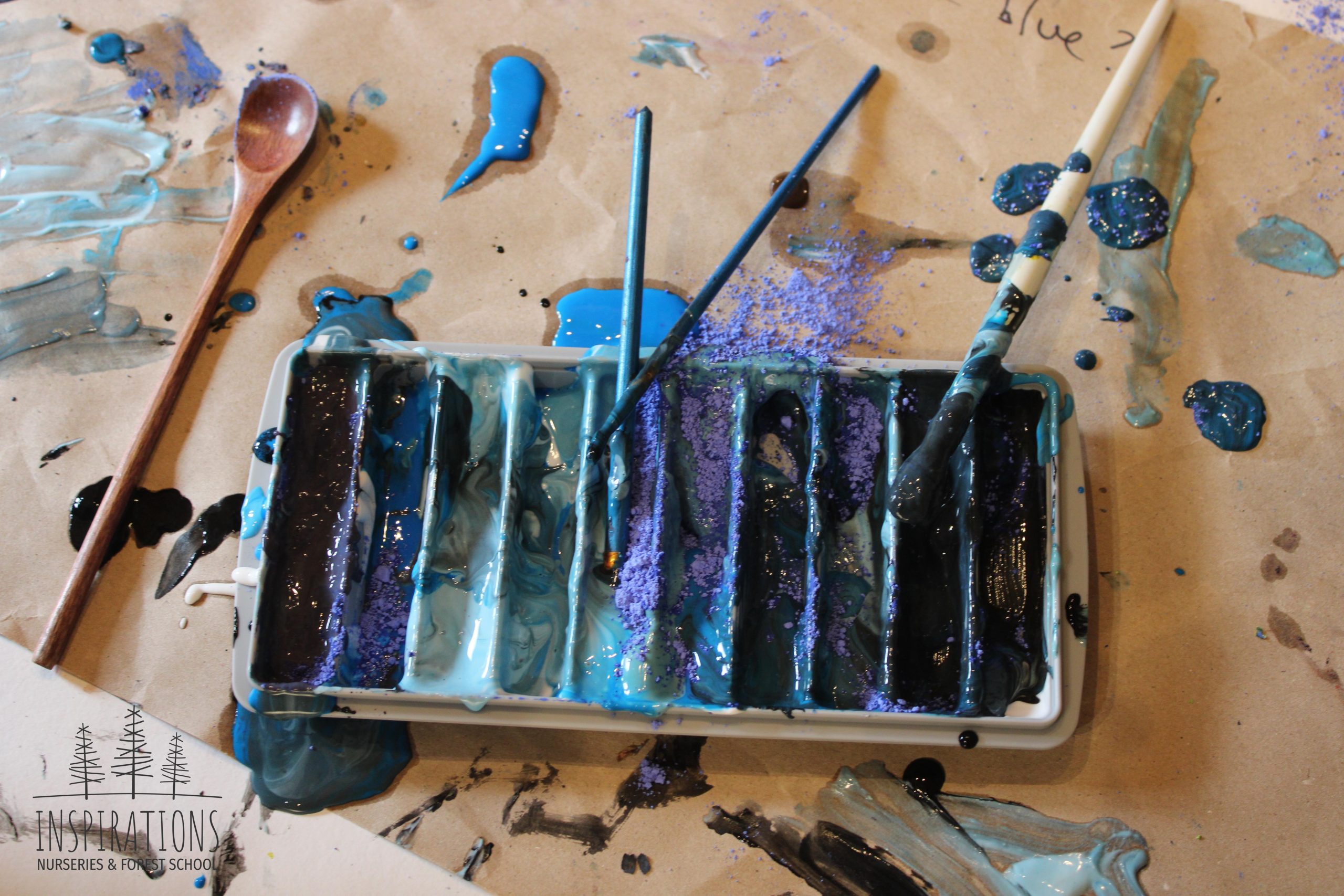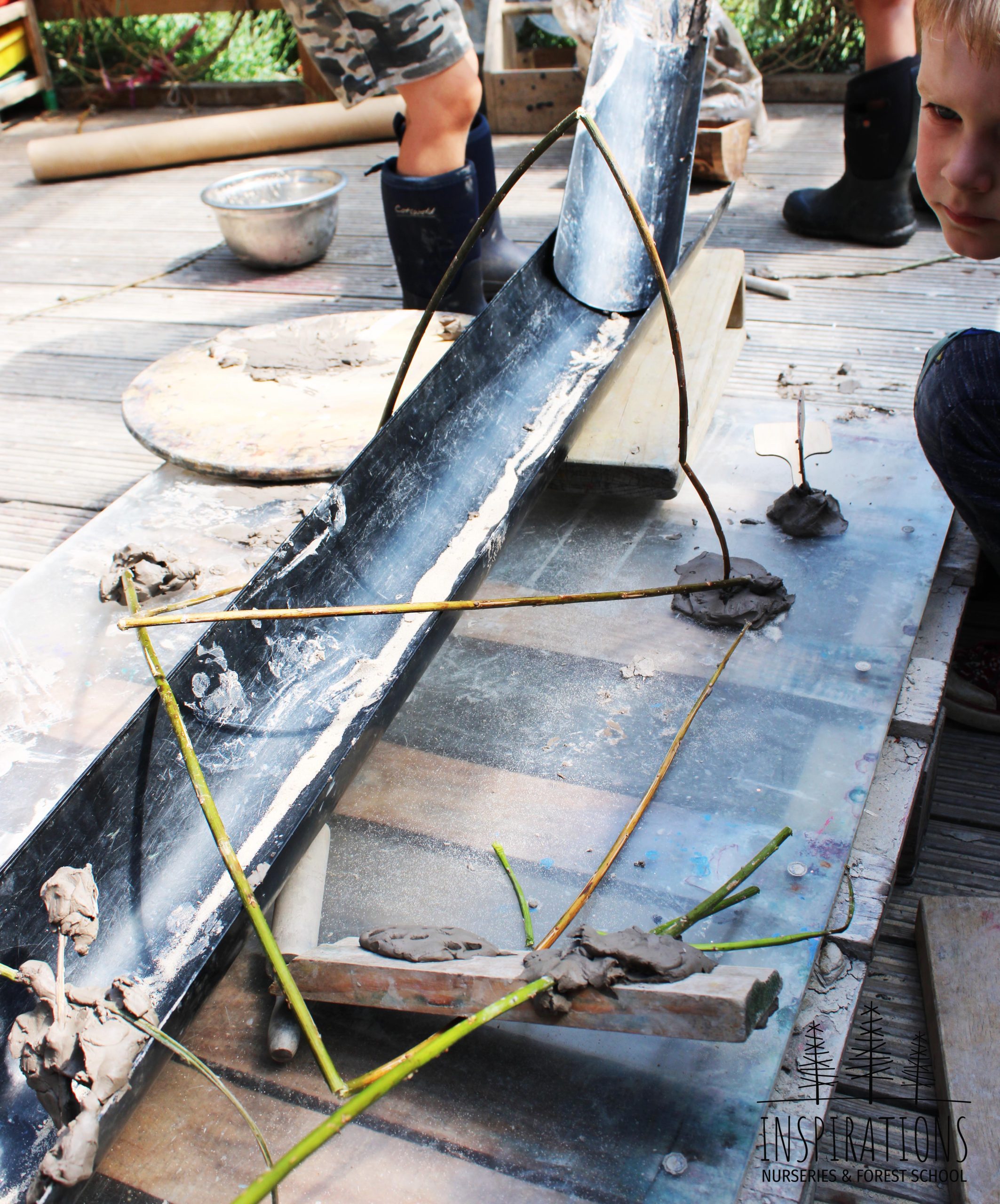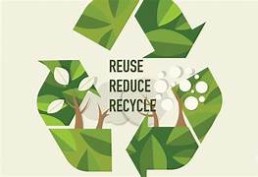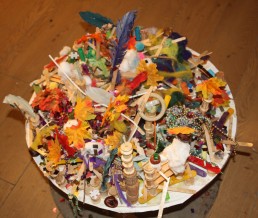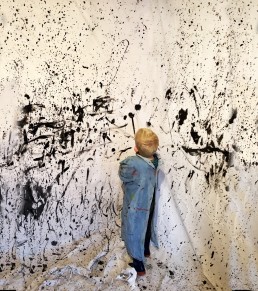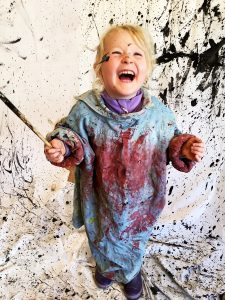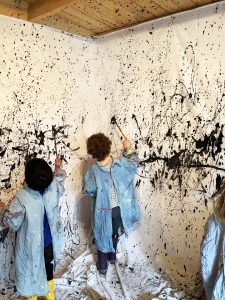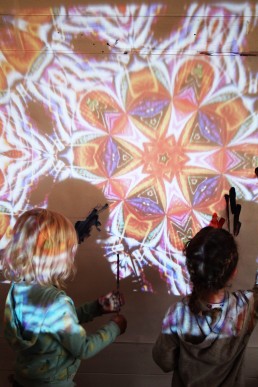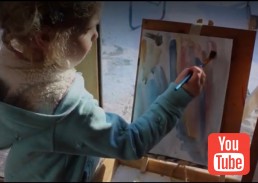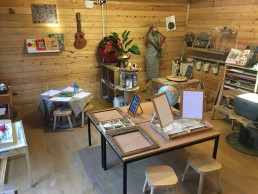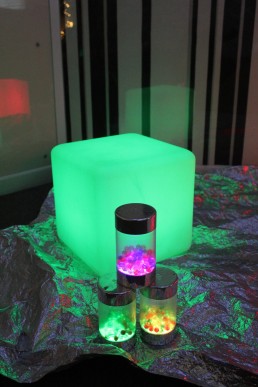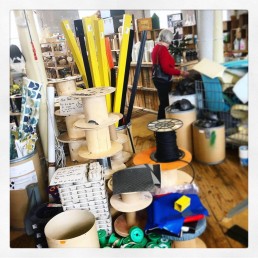Empowering the Child's Voice Through Art
This July, my self (Nathalie from the Art Studio) and Tara took part in an early years conference 'Using the Arts for the Children's Wellbeing and Communication: A holistic Approach'. It was delivered as part of a funded Arts Council Partnership called 'Tuneful Chatter,' and was a wonderful reminder of why we do what we do at Inspirations Nurseries in terms of creativity and the 100 languages of learning.
At the beginning of the conference we were asked to write down 'What do we want for this child' in any given learning opportunity. The answer I wrote down was 'I hope the child feels confidence to experiment with materials and to learn from mistakes so they can build confidence. I hope the child discovers something they love doing'.
So how do we ensure we are doing this at inspirations? This is why the child led approach is so important. In the Art Studio, our purpose build creative space for pre-schoolers, a pirate interest became a common theme for many of the children. It came pretty much from nowhere, but it was our job to follow it, the children were heard, and the room reflected that.
Over the weeks we have explored this topic in many expressive arts, but after creating a collaborative treasure map I stepped back and observed. It became apparent the interest was in the process of creating paint to represent the sea. The real interest here was not at all the end result of the treasure map, but it was the process. So, inspired by the sea, we have spent a whole week now dedicated to mixing shades of blue, and it has kept their attention for such a huge amount of time.
Art is a form of expression
Art is a communication tool; a tool for voice. Our job is to empower that child's voice. When the children in the Art Studio sit with the palettes and paints experimenting with colour, in that moment that is their language of learning; they are being heard; they are getting exactly what they want from the moment. When this happens, we have done our job.
Some of the children used this session to mix paint to make 'blueberry crumble', and pour the paint into biscuit trays, and that is ok. As the educator we do not prescribe outcomes, this is not paint by numbers.
Children have 100 languages of learning and it is our job to match that, not restrict it. When a child is full of potential there is hope and they know that you believe in them.
In order to create these enriching environments we also need to think about the community we are building in our classrooms. Our children pick up on feelings, part of our job in this type of setting is to make the place full of wonderful conversations. Wonderful conversations between staff, animals, each other and to do this we have to understand our selves and be compassionate to our selves and others. Ultimately, Inspirations is a community, filled with deep learning and joy from all.
So what do we want for our children?
'Our task regarding creativity is to help children to climb their own mountains. No one can do more'- Malaguzzi 1988
Thank you to the Doncaster Council and Tuneful Chatter for inspiring conference, and reminding us of the importance of all of the expressive arts in the early years.
-Nathalie
Meaningful Art
At Inspirations Nurseries all of our rooms have a focus on creativity, and our Pre-School room have access to our Reggio Emilia Inspired Art Studio, where the children and the Atelierista follow interests to develop and learn through all forms of expressive art. But what should children's art look like? And what makes meaningful art?
I remember as a child being given a template to colour in at school, which is a lovely pastime, but looking back now it feels so hollow. Sure we were given the freedom to choose whatever colour we wanted, and the challenge of trying to stay within the lines, but are there any meaningful moments created here? I used to spend my weekends creating dolls houses from cereal boxes, recording my own radio shows and even creating sculptures from the babybell cheese wax. It was in these moments of creating something out of nothing where meaningful moment were made.
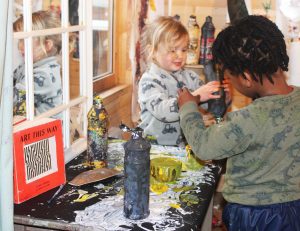
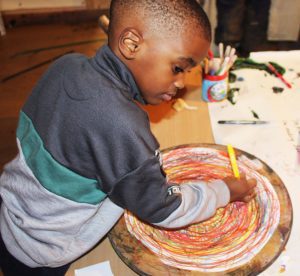
Children express themselves in so many ways, we call this the 100 languages of learning. When it comes to children's creativity, the adult can sometimes get in the way of the children's full potential, and sometimes the fear of 'mess' is a huge barrier at home. This is why the Art Studio is that place for children to create using their whole bodies, their senses, their hands and their voices.
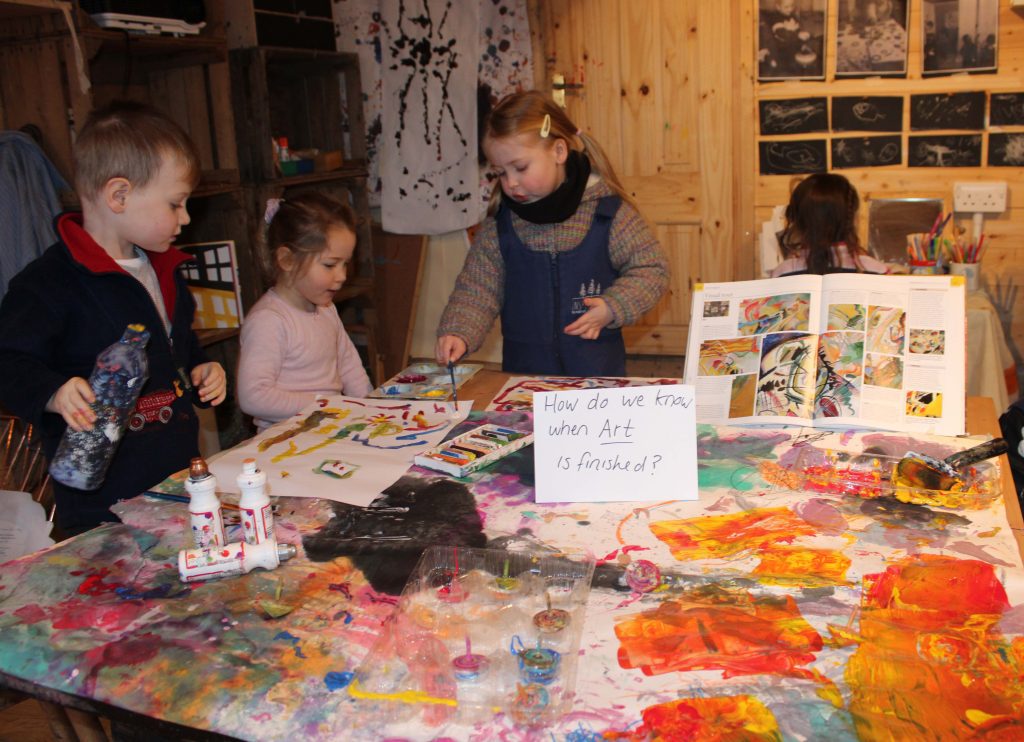
What makes meaningful Art?
Well, to put it simply, meaningful art happens when the child is fully immersed in the process. We pin too much expectation on what children's art should look like, and put too much focus on a finished product to bring home and stick on our fridge. If we remove that preconceived idea of what a child's creation should look like, then the barriers come down and imagination is unlocked and learning really starts to happen. Art, much like learning is a process, a chance for them to test ideas out, experiment with colour, embrace mistakes, learn the properties of materials, and sure, none of this can happen without mess!
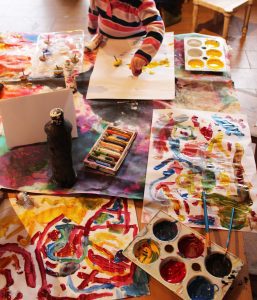
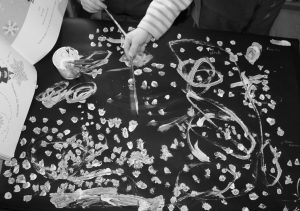
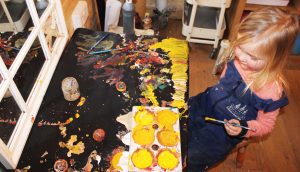
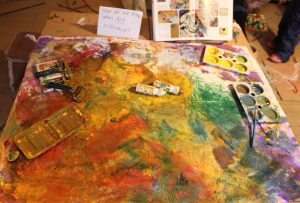
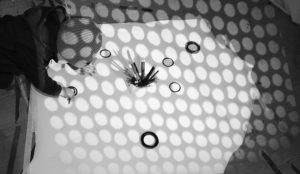
Removing our preconceived ideas of the process or end result doesn't mean the activity is without intent. At Inspirations our activities are open ended, but there's always intent behind it. When setting up any activity, as the educators we ask our selves 'what do we intend them to learn?' and 'how will we implement this?'
Art is not about conforming, the very essence of art is to be free and explore. You may have noticed at Inspirations we don't send children home at christmas with crafts, we don't line our children up in a production line to make valentines cards with a template thought up by an adult. This is because we always put our children at the centre of their own learning, it is their ideas that are to be tried and tested, their mistakes that are learnt from, and their experiments that are creating the blueprint to their future brain connections. When we provide the space, the time and the materials and follow their lead the results are magical, and the process leaves a lasting impression.
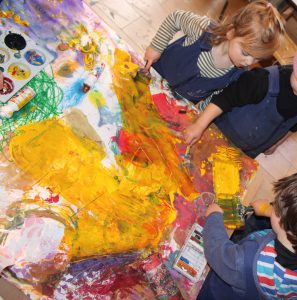
-Nathalie
Reduce Reuse Recycle

Welcome to our Inspirations Eco- school blog.
We can’t wait to share all our activities and eco-projects that will be happening in our setting.
The Early Years is a crucial time to install a love and respect for the environment in our children and
we are so lucky at Inspirations to have the perfect environment to do this. We are committed to
providing our children with a green and sustainable education.
Our Forest School is offered all year round as part of our daily pre-school activities. Between these
off-site sessions forest school activities take place on site around our veg garden, wildlife pond and
within our extensive grounds. We have implemented various eco-friendly practices to reduce our carbon footprint by encouraging reusable water bottles, recycling paper, taking part in this year’s Big Battery Hunt, and even making our own paper!
Our outdoor area is a nature inspired learning space. Our children have enjoyed making bug hotels
to provide a safe hideaway for wildlife. Our well-built hotels can shelter anything from hedgehogs to
toads, solitary bees to bumblebees, ladybirds to woodlice.
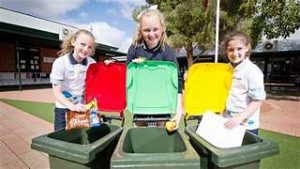
We also participated in Plant life's annual campaign No Mow May. Educating our children on the
importance of boosting flowers, and nectar, available to pollinating insects such as bees, butterflies,
and moths. This then also allows spring flowers to set seed and plants to establish themselves in
advance of the summer.
At Inspirations we believe that by introducing eco-friendly and environmental education at an early
age, we are nurturing a generation of responsible and environmentally conscious citizens. Our vision is that all our children grow up with an understanding of the impact their actions have on the planet and are developing a sense of responsibility towards it.
We are so excited to be starting our eco-school journey in the new academic year, working towards
our first Eco-Schools Green Flag. We also have a community project that we are so excited to get
involved with and can’t wait to share with you.
Together, we can make and create a greener and more sustainable future.
Tara Slade.
The Sticking Table
Much more than just loose parts and glue
 Back in June, shape and structure created from loose parts became a shared interest, the children would make 2D shapes and arrangements with lolly pop sticks. Naturally this progressed into 3D shapes as the children explored the idea of building upwards with bobbins and corks added in.
Back in June, shape and structure created from loose parts became a shared interest, the children would make 2D shapes and arrangements with lolly pop sticks. Naturally this progressed into 3D shapes as the children explored the idea of building upwards with bobbins and corks added in.
We wanted to find a way of making these structures more permanent, a way of their models being able to interact with each other instead of standing alone on a shelf. From here the Sticking table was created!
An old repurposed cable reel became a platform for these structures and ideas to play out, and old objects took on new roles with the help of some glue, a lot of glue in fact.
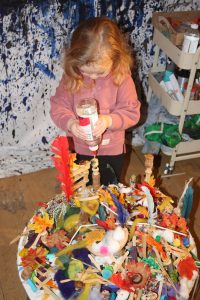
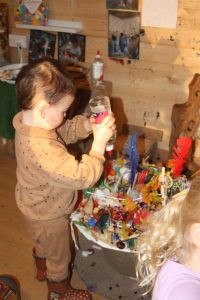
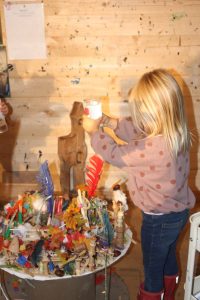
‘Sticky sticky glue’
The glue is poured from squirty bottles from heights, or from close distance, the children watch it pour and dribble. They watch how it builds up and falls off certain surfaces onto a surface below. They practice their aiming skills and try again when the glue doesn’t land where they had in mind. Children love being able to access resources them selves, the joy and independence they get from unravelling tape and pouring glue can’t always be fulfilled at home due to mess and waste, so this was the perfect place for them to pour glue to their hearts content. We used PVA, clear glue, old pen lids destined for the bin, feathers, wool, bobbins and sticks and each week the sticking table carried through with a new story.
The sticking table has been a house, a nest, a city, and a dragon house. For now the sticking table is going though a seasonal autumnal phase as conkers and leaves are added to the mix.
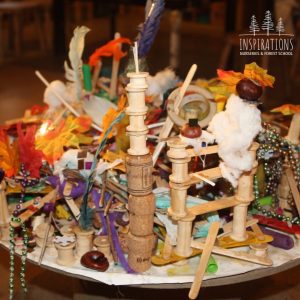
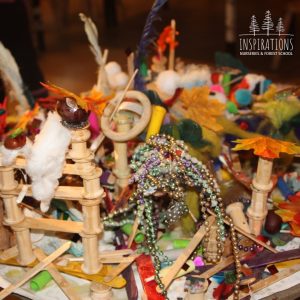
Having a long term project along side other activities can be a great way to allow children to practice and repeat skills, by revisiting ideas from weeks before they are able reflect on their ideas and build confidence. Schemas are a repeated pattern of behaviour that a child will go through whilst discovering how the world works. It is through this urge of repetition our children are given the time and opportunity to extend on their thinking and learning.
It can be hard as educators to have the chance to leave a project out, tidy up time is a necessity particularly in spaces where meal times take place. So the sticking table is the perfect place for them to come back to a scene that has not been tidied away from the last time they were in the Art Studio. The perfect opportunity for them to deepen their cognitive development. Because how else can our children reflect on their work and ideas when they return to a project that has been tidied away.
Only the children can predict where the sticking table will go next, but as each new group of creative minds come together to take ownership of it, it will, no doubt, take on a brand new adventure and identity over the coming weeks and months.
-Nathalie
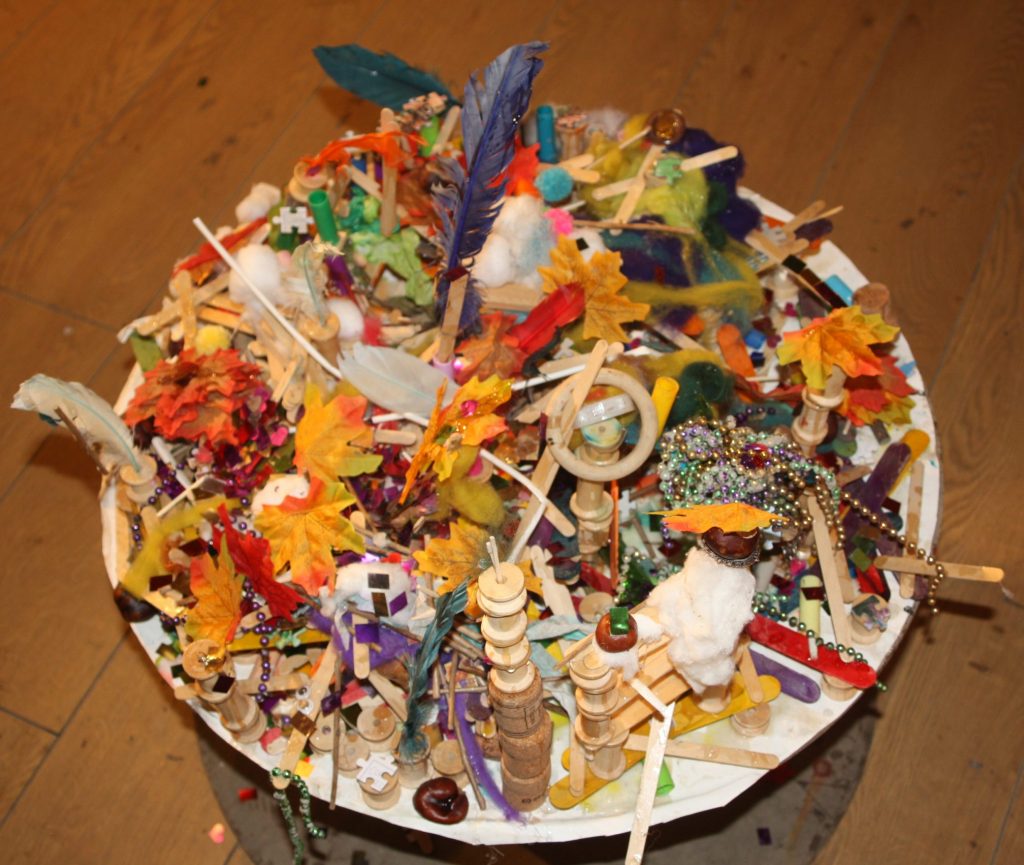
Art vs Craft
What is a craft?
A creative activity with a predetermined outcome and there is nothing wrong with it, it can be a nice way to relax or create a keep sake, particularly for adults. In fact new skills can be learnt in the process and concentration skills can be encouraged. Take for example knitting, and sewing, a skill that needs to be learned with instruction in order to create the desired outcome.
However, at Inspirations we believe there is a time and a place for a craft, and we would much rather encourage unique creativity without boundaries. With everything we do and make in life we draw inspiration from other peoples ideas, take for example the current interest in Jackson Pollock in the Art Studio. His method of painting has inspired us to try it our selves, but when it came to creating this piece of art, through trial and error and experimentation, the outcome is decided by them, and that is the important factor.
Who are we to tell our children what their art should look like?
We believe there are more creative options to crafts. By providing our children with tools, and telling them what to make and how it should look is projecting our ideas onto them, when the children should be at the centre of their own learning. Our role is not to tell a child what colour something should be, and we most definitely shouldn't be giving our opinions on how 'good' something is at the end of a creative session. These restricting activities have the potential for huge disappointment and create a barrier to the child venturing down their unique path of creativity. At Inspirations we use encouragement over praise, and if a child is looking for a comment on their drawing I will try to use factual language such as 'i see you used lots of green!' 'you seemed really focused whilst making that' or 'you must be really proud of that'. Factual statements instead of us giving our opinion will help build self esteem instead of encouraging them to do things to impress others.
We are a place where mistakes are part of the journey, and the process holds more importance than the end result. Open ended activities are important in early child hoods development. Of course they promote imagination and creativity, but they also encourage problem solving skills and social emotional development. Creativity doesn't just include drawing and making, it includes role play, dress up, music, building from cardboard boxes, magnets, loose parts, building blocks..the suggestions are endless and all a part of the 100 ways of learning. They piece together to make each unique child, who has learned new skills and ways of learning through experimenting and ideas, with us there to ask open ended questions.
How can we help support creativity?
Whilst allowing our children to play and learn we can support them by asking open ended questions. They might not always answer, a good sign they are truly engaged, but some questions you can ask at the right time will support them in extending upon their own learning.
- Tell me about that?
- Why do you think…?
- How do you know…?
- I wonder what might happen if you...?
- Why do you think this happened?
- I wonder if you will add anything?
- What can you do about it?
- What do you think would work?
- How do you think it could work?
- Can you do it another way?
- How are these the same?
- How are these different?
- What do you think comes next?
- What else can you do?
- What does it remind you of?
So next time you come to do a craft, why not encourage your child to take a unique spin on it. By removing that set outcome you will find the pressure is gone and creativity flourishes.
-Nathalie

Exploring Pattern in the Art Studio
This week in the Art Studio has had a child led focus on pattern, but how did we get there? Last month we found a butterfly on the decking that was no longer alive. The children shared ideas on what might have  happened? 'It got stung by a wasp!' 'It was eaten by a fox!'
happened? 'It got stung by a wasp!' 'It was eaten by a fox!'
Whilst they came to their own conclusions we brought the butterfly into the Art Studio for a close examination. Out came all the research books as we identified it as a 'Speckled Wood'. The butterfly inspired some drawings, which lead onto paintings with particular focus on the wing patterns and colours.
This naturally lead onto art work and printing techniques by folding the paper to make prints of butterfly wings as we learnt a new word 'Symmetrical'. Their symmetrical patterns progressed and this interest strayed away from the butterfly and lead onto pattern within art using various techniques.
This week we took our pattern painting onto a large scale with the added media of light and shadow as a kaleidoscope was projected onto the wall. We also used clay to create pattern by imprinting beads and various other loose parts.
The Art Studio as well as being a Reggio Inspired place to explore project based learning is also a space for our children to explore new surroundings and new friendships in smaller groups. For some it is their space to build with the magnets, notice new books, experiment with different art materials and explore shadows on the projector. It is a space that can be quiet, a space that can be loud, where we play instruments and sing with the ukulele, and a space with provocations, a space that is rearranged whenever new interests emerge. With between 6 and 8 children in each session it can be the perfect opportunity to hear the children's voices which guides our planning.
Here's some of this weeks photos from the Art Studio.
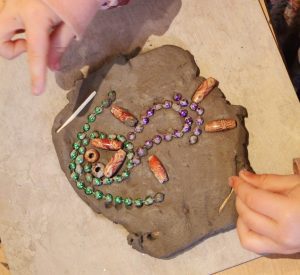
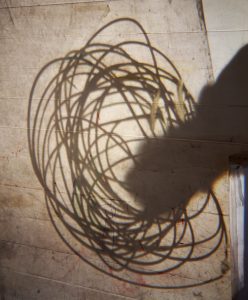
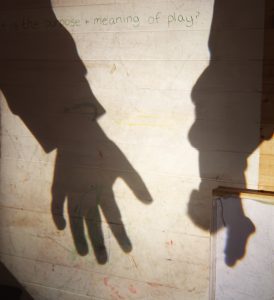


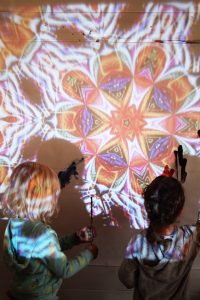

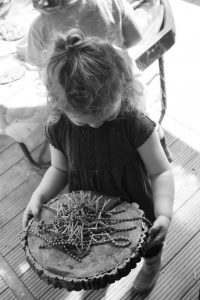


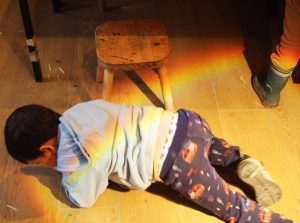
Seekers of Meaning
New Video
Over the last few weeks I have been filming the children as they explore the Art Studio. To read more about our Art studio you can go back to last weeks blog.
The children's current shared interest is construction and building houses from clay, bricks, sticks and blocks. Some of that is captured in our brand new video that you can watch here-
https://www.yout ube.com/watch?v=4-59qb9GgdQ
ube.com/watch?v=4-59qb9GgdQ
The Art Studio
Every morning and afternoon our Pre-Schoolers choose where they want to spend their time, between the Yurt/Outdoor Classroom, Forest School or the Art Studio. There is a quaint pebbled path that leads us behind the Yurt, past the new pond and up to this purpose built creative space, but this isn't just any art classroom, we do things a little differently here. http://simonr30.sg-host.com/the-art-room/
Why do we have an Art Studio?
Of course creativity is woven throughout every aspect of our learning at Inspirations, there are mark making tools, paints and clay accessible in all areas, so why do we need an additional separate creative space? The Art Studio, (referred to as an Atelier in the Reggio culture) is so much more than just an Art Room. It is its own separate space for the children to own, re-purpose and re-visit week after week, and is set out to foster self discovery.
100 Languages of Learning
It is a space for smaller groups of children to branch off, be heard, share ideas, and develop the confidence to be leaders of their own research and learning. It is an environment that plays host to books, materials and tools that support the 100 ways of learning with the support of myself as the Atelierista. It is a space where children proceed through their inquiry to reach their hypothesis though guided experiments, mixed media, play, music, light and shadow, sculpture and dramatic play. A space for them to give meaning to, give identity to, and in turn put them selves and their ideas into context within the world they live in.








The walls of the Art Studio are a canvas, a projector screen, an art exhibition and a metaphorical mirror reflecting the evolving learning journey of our children. Through photos and quotes of the children's voice on the wall the children can see where their ideas started, where they are now, and by reading back the children's own words they see that their inputs are recorded, valued and remembered.
It's also important to note that the Atelierista is not an art teacher, rather, an Artist who knows the potential of art materials and children, and the limitless possibilities when these are combined.




Beautiful Mistakes
In the Art Studio the children are not afraid to try new things, because fear of failure doesn't exist. How can it exist in a place where mistakes are simply learning opportunities. A fallen glue pot can become an art project in its self, and a drawing gone wrong can inspire new ideas. One project that stands out began when a child wiped up spilt watercolour paint from the floor with a baby wipe and watched as the colours soaked through the wipe. He then decided to add baby wipes to a canvas, the 'dirty' baby wipes themselves then becoming the art.
Seekers of Meaning
As constant seekers of meaning, our children are making sense of the world around them with everything they do, and our Art studio is one section of our pre-school that fosters this.
This week we will be filming inside the Art Studio to see their explorations brought to life, this short film will be shared on You Tube next week.
- Nathalie
Learning through Light
The Reggio approach (as outlined in our previous blog) puts children at the centre of their own learning. The ethos is based around a hands on approach to learning, with art, materials, and loose parts used to create learning opportunities and encourage critical thinking; but one thing we haven't touched upon much is the use of light as a material.
If you explore our rooms at inspirations, or the photography on our Instagram and website you will see there are projectors, light boxes, and sensory dark dens throughout all of our spaces from the Baby Rooms up to Pre-School.

Why do we use light and shadow?
In the younger rooms the use of light cubes, fairy lights and projectors invite children to expand their natural curiosity and encourage babies to engage and remain focused for a longer period of time. As well as having a calming affect, this sensory experience also provides a different perspective, allowing the child to develop creative and critical thinking.

In the Toddler and Pre-School rooms we use over head projectors, torches and mirrors to allow the children to deepen their knowledge and understanding of light and space. Have you ever witnessed the first time a child acknowledged their own shadow?
Seeing their reaction just highlights the sense of magic and wonder that comes with light play. In the Reggio Approach we talk about natural objects a lot, and sun light alone is a completely free resource that should be utilised to support learning. Light and shadow can be a source of intrigue as children notice the way in which light changes the way things look. It gives the child the opportunity to witness the illumination of things around them, predict patterns, test their ideas and develop new concepts.
We set up a camera in our baby rooms to see how they interact with light, you can watch the video here-
At home why not set up an activity for your child based around lights, shadows or reflection using mirrors, we would love to be tagged in a photo of your activity on tapestry, Instagram or Facebook.
“light and certain light phenomena are central protagonists and highlight the extent to which expressiveness and beauty can accompany an understanding of scientific thinking.” - Vecci (Reggio Atelierista)



For more reading on this topic you can find 'Art and Creativity in Reggio Emilia: Exploring the Role and Potential of Ateliers in Early Childhood Education (Contesting Early Childhood)DF' on amazon.
- Nathalie (Atelierista)
Something Out of Nothing
‘In any environment, both the degree of inventiveness and creativity, and the possibility of discovery, are directly proportional to the number and kind of variables in it.” - Simon Nicholson
 As the changing seasons are constantly providing us with natural loose parts, at Inspirations we are constantly adding to our materials and resources, reinventing the classroom and replenishing our supplies. We are always on the look out for cable reels, pallets and tyres locally to ensure our environment is a constant source of stimulation. SCRAP (Scrap Creative Reuse Arts Project Ltd) is one place in particular that provides us with many open ended resources, and this week was time for another haul.
As the changing seasons are constantly providing us with natural loose parts, at Inspirations we are constantly adding to our materials and resources, reinventing the classroom and replenishing our supplies. We are always on the look out for cable reels, pallets and tyres locally to ensure our environment is a constant source of stimulation. SCRAP (Scrap Creative Reuse Arts Project Ltd) is one place in particular that provides us with many open ended resources, and this week was time for another haul.
Since 2004 SCRAP has been a social enterprise based in a creative space at Sunnybank Mills, Farsley, Leeds, and if you haven't been we thoroughly recommend it.
Want to know more about our nursery? Call 0113 2585800
Viewing Objects in a New Light
There's something about walking into SCRAP that ignites our imaginations regardless of age. Being surrounded by so many types of materials sparks joy and opens up a feeling of endless possibilities, it invites you to see the magic in objects that would otherwise be discarded. Scrap is a place that encourages us to view old objects in a new light, and it is exactly what we aim to do at Inspirations Nurseries.
It was Simon Nicholson who developed the theory of loose parts in 1971, he proposed that open ended materials could empower young children creatively, and that the presence of such materials and objects inspire children to construct, manipulate and transform through self directed play. The idea of loose parts goes far deeper when we consider it being combined with additional sources such as gravity, music, light and shadow which we will look into further as we move our focus to include the Reggio Emilia approach as a whole.

 Here are some of the items we got from SCRAP this week, which have been implemented into each room. This week we will be recording ways in which our children use some of these items in play and how they adapt them for construction, art projects and role play. We will share this footage on our Youtube and social media accounts so stay tuned.
Here are some of the items we got from SCRAP this week, which have been implemented into each room. This week we will be recording ways in which our children use some of these items in play and how they adapt them for construction, art projects and role play. We will share this footage on our Youtube and social media accounts so stay tuned.
There's something very inspiring seeing how children can make something out of 'nothing', and this is a reminder that people of all ages need to allow time and space to make connections between all the little things that our larger ideas are built from.
- Nathalie
 Scrap is open to the public Weds - Sat, and includes a reSTORE eco friendly refill store. Please ensure you are wearing a face mask due to the current restrictions or you can buy one there from a selection of handmade reusable materials.
Scrap is open to the public Weds - Sat, and includes a reSTORE eco friendly refill store. Please ensure you are wearing a face mask due to the current restrictions or you can buy one there from a selection of handmade reusable materials.
For more information about our nurseries call us on:
Adel: 0113 2612262
Horsforth: 0113 258 5800
